The Whale Sanctuary Project has joined an emergency effort in the Pacific Northwest to try to save the life of the orca J-50, also known as Scarlett. The four-year-old whale is emaciated and starving, and the National Oceanic and Atmospheric Administration (NOAA) is working with several organizations to help her. Two of our team members, Jeff Foster and Katy Laveck Foster, are coordinating much of the field work. NOAA is also monitoring the behavior of Tahlequah (J-35), who gave birth to a daughter on July 24th. The infant survived only a half-hour. And in an unprecedented display of grief, Tahlequah has been carrying her daughter’s body around.
We are updating this page regularly to keep you informed of how Scarlet and Tahlequah are doing.
September 13: From NOAA.
Unfortunately J-50 has not been seen in several days of favorable conditions and repeated sightings of her pod and family group, including J-16, her mother. Teams were on the water searching yesterday and are increasing a broad transboundary search today with our on-water partners and counterparts in Canada.
We have alerted the West Coast Marine Mammal Stranding Network, which is a tremendous resource in such situations. Airlines flying in and out of the San Juan Islands are also on the lookout. The hotline for stranding reports is 1-866-767-6114.
September 12: 9 am PT. NOAA will be holding two public meetings this weekend to outline the basic options that now being considered for Scarlet/J-50. Your participation is welcome. The meetings will be:
- Saturday, Sept. 15, at 7 p.m. at Friday Harbor High School in Friday Harbor, Wash.
- Sunday, Sept. 16, at 1 p.m., at the University of Washington, Haggett Hall Cascade Room, in Seattle.
Next steps could include a rescue operation and hands-on physical examination. That could lead to rapid treatment and return to the water, or short-term care and rehabilitation to improve her chances of survival.
In order to minimize potential stress to the rest of Scarlet’s family, response teams would act to rescue her only if she becomes stranded or separated from the rest of her family. And the overriding priority of any rescue would be to evaluate, treat, and rehabilitate her to give her the greatest chance of survival while ensuring her return and reunification with her family as soon as possible.
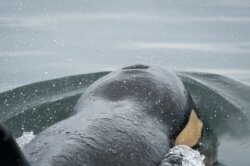
Scarlet Sept. 8, 2018. The dent behind her head shows her emaciated condition. Photo by Katy Foster/Whale Sanctuary Project, under permit 18786.
September 8: From NOAA
Scarlet/J-50 was seen lagging a half-mile to a mile behind the rest of her family group at times on Friday (Sept. 7), and her body condition is not improving. She appeared to have lost more weight and looked very thin.
With growing concern, we are working with Fisheries and Oceans Canada (DFO) to evaluate options.
Our highest priorities are to do all we can to ensure J50 remains a contributing part of the Southern Resident killer whale population and to prevent any harm to her and her family under any potential response scenario.
That is the bottom line.
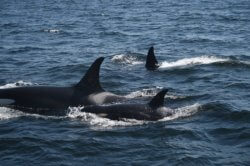
Scarlet with other members of J Pod. Photo by Candace Emmons/NOAA Fisheries, under permit 18786.
September 6: 2 pm PT – from NOAA
We now have some results of the fecal and breath samples the team collected to better understand and diagnose Scarlet/J-50’s condition. We reported back on August 17 on the first fecal sample, which was collected from a small group of J Pod whales, including J-50.
Genetic analysis determined that the sample is likely from Slick/J-16, Scarlet’s mother. This sample showed evidence of parasitic worms. Since Slick catches fish that she then shares with Scarlet, the veterinary team prioritized treating Scarlet with a dewormer, following antibiotics. A second fecal sample was identified as from J-27, an adult male.
Researchers at our Northwest Fisheries Science Center in Seattle have meanwhile extracted DNA from the breath sample collected on August 9. While the sample was small and yielded little DNA, researchers are adapting their analysis to make the most of the available material. We will update you when we have more information.
September 6: 8 AM PT. This morning, the Whale Sanctuary Project posted the following statement about next steps in the treatment of Scarlet:
“There has been much discussion over the past couple of days about the next steps that should be taken to help Scarlet. The Whale Sanctuary Project supports continuing treatment for Scarlet while she is free-swimming with her family group. Only if she were to live-strand or to become separated from her family would we support taking her to an ocean-based sea pen for temporary treatment prior to returning her to her family. Under no circumstances would we support transferring Scarlet to an entertainment park or aquarium.”
September 4: – from NOAA – Once again, Scarlet impressed scientists on Monday as remarkably active and engaged with her family, J Pod, despite her severely emaciated condition. Never have researchers seen such an emaciated whale defy the odds for so long. Scarlet stayed close to her mother, Slick/J-16, and continued the longer dives expected of healthy whales.
Researchers from SR3 and NOAA Fisheries Southwest Fisheries Science Center collected new aerial images of J-50 and other J Pod whales for comparison to a 10-year time series to assess growth and body condition.
Veterinarian Dr. Martin Haulena of the Vancouver Aquarium gave Scarlet another dose of antibiotics through a dart. (Her first dose was on August 9.)
The treatment priority has now shifted to administering a dewormer, also through a dart, to reduce any parasitic burden on Scarlet’s system. Teams did not get the chance to provide the dewormer on Monday, but will continue to attempt that, depending on the location of the whales and conditions on the water.
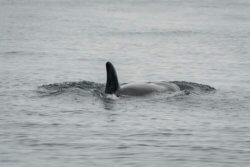
Scarlet/J-50 off the west side of San Juan Island on Aug. 11, 2018. Photo by Katy Foster/Whale Sanctuary Project, under permit 18786.
September 3 11.45 am PT. We’ve been hearing reports for the last hour that Scarlet has been sighted with her family. NOAA has now confirmed this, saying:
“Good news! Multiple organizations are reporting that J50 has been spotted with J Pod in the U.S. waters of the Salish Sea this morning. We will continue our efforts to assess the health of J50 and treat her according to the priorities outlined by our team of veterinarians and scientists.”
September 3: 9.30 am PT – from NOAA – We are disappointed to report that J-50, the young female Southern Resident killer whale also known as Scarlet, did not return from open waters off the West Coast of Vancouver Island to the Salish Sea with J Pod over the weekend. Biologists from Center for Whale Research, Vancouver Aquarium, Soundwatch, and the University of Washington spent much of the day Sunday (Sept. 2) with other members of J Pod, including J-16, her mother. Scarlet was not seen with them.
We all hold out hope that J-50 is still alive, and we are in touch with the Pacific Whale Watch Association, Fisheries & Oceans Canada (DFO), and other organizations with eyes on the water to check for any other recent sightings, which may help us determine where to look more closely.
We all know J-50 as tough and tenacious. One of the last sightings by DFO on Thursday (Aug. 30) reported that J-16 and J-26, J-50’s brother, were lagging behind most of J Pod by about three nautical miles, and J-50 was lagging about a half-mile behind them. Sometimes she got closer, but she looked to be struggling to keep up.
The standard for determining the loss of any of the Southern Residents is to spot a whale’s family group multiple times without them. This rule may be relevant for J-50 to confirm her status given how far behind the other whales she had followed at times.
We do know that J-50 had lost a great deal of weight in recent months. Biologists recognized her condition as grave. An international team of biologists, veterinarians, tribes, and other partners had mobilized an unprecedented effort to try to support J-50 through health assessments and treatment.
We and our many partners are hopeful that the additional efforts to follow up on sightings and take advantage of all the organizations on the water today will give us more information about J-50 and J Pod. We will update everyone tomorrow.
August 24: Scarlet and the entire J pod have not been seen in the area of the San Juan Islands since our last update. They were observed in Canadian waters on Wednesday (Aug. 22nd), but were farther out to sea than the research boats can practicably reach – meaning that by the time the boats reach the place where there’s been a sighting (like from the air), the whales are likely long gone. And given the distance involved, there’s not enough time for a round trip transit plus time near the whales.
We need to wait until they come closer to land. But we’re also aware that as fall comes closer, the Southern Resident orcas all routinely move further out to sea, where the food supply is better at that time of year. So, the window of opportunity will likely be closing in the coming weeks.
(Note: Check out our Facebook page for new video from Jeff and Katy Foster.)
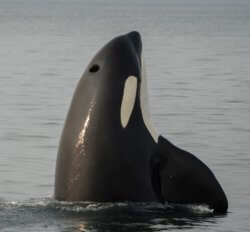
Scarlet’s mother, Slick/J-16, spyhops as her daughter waits close by. (Photo: Katy Foster/NOAA Fisheries, under permit 18786)
August 20: 2 pm PT – from NOAA Response teams spent about three hours on Saturday (Aug. 18) monitoring Scarlet as J Pod returned to the Salish Sea on the way towards San Juan Island.
Biologists aboard a SeaDoc Society vessel reported Scarlet actively socializing with the rest of the pod, a hint that her condition may be improving slightly. She fell behind as the whales swam east, but a University of Washington (UW) team saw her rejoin her mother Slick/J16 and sister Echo/J42 to forage near Hannah Heights on the west side of San Juan Island. The UW team also collected two fecal samples from the group.
On Sunday, J Pod was seen heading west, back toward open ocean. The plan going forward is to administer another dose of antibiotic through a dart and, if possible, a second dart with dewormer to reduce parasitic worms, known to be harmful in emaciated marine mammals like Scarlet, and that were found in the recent fecal samples from a group of three whales including J50. The veterinary team believes another dose of antibiotic remains the priority to treat potential infection since the first dart on Aug. 9th delivered only half a dose. Darting a swimming killer whale who has thick skin, particularly on fins and flukes, from a rocking boat is challenging. To ensure that J50/Scarlet receives the medication, veterinarians may switch to a collared needle with a ridge that holds it in place long enough to deliver the full dose. This type of dart is commonly used to treat wildlife, such as elephants, and will fall out in time.
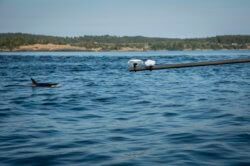
Collecting a breath sample from Scarlet. (Photo: Katy Foster/NOAA Fisheries, under permit 18786)
August 17: Test results from the health samples collected from Scarlet/J-50 are starting to come in from several top laboratories around the country.
A fecal sample collected last weekend from Scarlet and from her mother Slick/J16 and her sister Echo/J-42 showed high levels of Contracaecum, a nematode parasite that is commonly found in killer whales and other marine mammals.
The worm is not usually a problem in healthy animals. However, in animals that are emaciated or are otherwise compromised, the parasite can penetrate the stomach lining, introducing bacterial infection to the bloodstream, or it can bore into internal organs. While we cannot be sure the sample came from Scarlet, the veterinary team has updated her treatment priorities to include antibiotics and a dewormer. Both have proven successful and safe in other cetaceans. The treatment should help Scarlet by reducing bacterial and parasitic burdens on her system so she can start regaining the weight she has lost.
The whales remain in open waters off the west side of Vancouver Island, beyond the reach of the response teams.
August 14: The J pod has headed out into open waters for a few days, so the team won’t be able to work directly with Scarlet until the pod returns. Meanwhile, NOAA posted the following this morning:
From NOAA – “Now that the response team has met all the initial goals for Scarlet/J-50’s health assessment and treatment, and the J Pod has headed out to open waters, biologists and veterinarians are taking stock of what they have learned so far. They are reviewing video footage and photos and processing samples to gain further insights into Scarlet’s health and behavior. The Department of Fisheries and Oceans Canada, University of Washington, Center for Whale Research and other partners continue to monitor the whales and collect fecal and prey samples (e.g., fish scales) when possible.
“The teams will also review the results of the feeding trial on Sunday, August 12th, while they determine next steps. We are grateful to all our partners for their help, patience and support over the past few weeks. The response team thanks all of you who are following this story closely for your support and positive wishes. Recovering these whales and the West Coast salmon runs they depend upon will take all of us.”
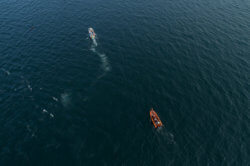
Lummi Nation vessel (top) releases live fish during trials near San Juan Island on Aug. 12, 2018. (Photo by John Gussman/NOAA Fisheries, under permit 18786)
August 13: noon PT – From NOAA:
Favorable conditions yesterday allowed the teams to proceed with an experimental live fish release off the west side of San Juan Island to evaluate the process as a way to treat Scarlet with medication and supplements.
Under the direction of Jeff Foster of the Whale Sanctuary Project, a Lummi Nation vessel released eight live hatchery salmon about 75 to 150 yards in front of Scarlet, while teams observed from NOAA Fisheries and Washington Department of Fish and Wildlife (WDFW) vessels.
While she appeared to react to the released fish by quickly diving, biologists could not confirm whether she took the fish, and they are now reviewing aerial footage for further clues.
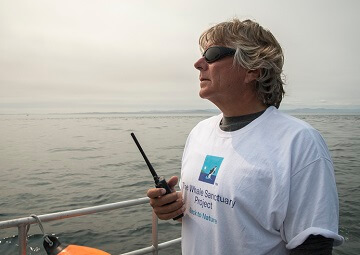
Jeff Foster coordinating the supplemental nutrition deployment from the Lummi Enforcement Vessel (Photo: Katy Foster/NOAA Fisheries, under permit 18786)
Scarlet socialized with other members of J Pod, at one point surrounded by a cluster of other whales but did sometimes fall behind in the strong current.
Researchers collected a fecal sample from the pod but could not confirm whether it was from J50 herself. Fecal samples can reveal whether the whales are eating and what they are eating, as well as providing clues about their health and gauging their stress levels by evaluating hormones such as cortisol.
The whales appeared to be headed back west toward the open ocean this morning, and teams were standing by for further sightings.
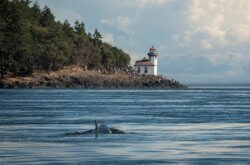
J-50 (Scarlet) off the west side of San Juan Island near Lime Kiln Lighthouse, Aug 11, 2018. (Photo: Katy Foster/NOAA Fisheries, under permit 18786)
August 12: 8 am PT – From Jeff and Katy Foster in the field:
We found J-50 (Scarlet) near Open Bay, Henry Island and spent about 6 hours with her today. We spent most of the time working with Dr. Deborah Giles and her crew from the Univ. of Washington trying to get a fecal sample and watching J-50’s behavior. We were able to get a sample but due to the close proximity of the animals it was difficult to tell which one it came from.
The J16’s (Scarlet’s mother and close family) were fairly spread out and J-50 spent most of her time alone, at times over a mile away from the other animals. The tides today were very strong and at one point she swam in the same spot bucking the tides for more than an hour while the other animals continued ahead, looking like she was having a difficult time keeping up. We’re going to try to get some fish into her midday Sunday.
August 11: 2 pm PT – From Ken Balcomb at the Center for Whale Research:
This afternoon, J-35 (Tahlequah) vigorously chased a school of salmon with her pod-mates in mid-Haro Strait in front of the Center for Whale Research for a half mile, no longer carrying the deceased baby that she had carried for at least 17days and 1,000 miles. Her tour of grief is now over and her behavior is remarkably frisky.
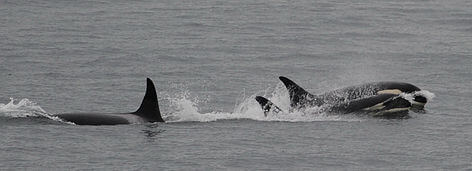
Photo of Tahlequah (J-35) with her family Aug 11. Telephoto digital image by Ken Balcomb/CWR
Telephoto digital images taken from shore show that this mother whale appears to be in good physical condition (no evidence of “peanut-head”) following her record-setting ordeal. There had been reports from brief sightings by whale-watchers two days ago that J35 was not pushing the calf carcass in Georgia Strait near Vancouver, BC, and, now we can confirm that she definitely has abandoned it. The carcass has probably sunk to the bottom of these inland marine waters of the Salish Sea, and researchers may not get a chance to examine it for necropsy.
August 11: 9 am PT: Yesterday’s plan was to test-feed live salmon to Scarlet (J-50) in waters off Washington State’s San Juan Island. NOAA wants to see whether medication can be given to her through live Chinook salmon (the sole food of the Southern Resident orcas).
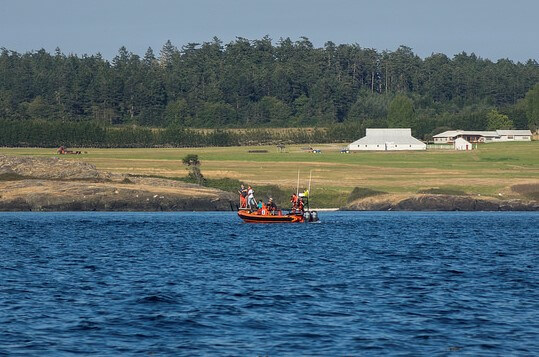
Dr. Marty Haulena, Dr. Brad Hanson, Candice Emmons, Jeff Foster, Katy Foster, & Trevor Foster on the NOAA health assessment vessel for J50 Aug. 9, 2018. (Photo: John Gussman/NOAA Fisheries, permit #18786)
But first, the team needs to test whether Scarlet will catch a salmon who is put into the water from a boat. So, two boats carrying live fish headed out in the early morning.
NOAA notes that the team watched as Scarlet repeatedly dove and surfaced where the pod was feeding. Biologists could not tell whether she also fed, but they collected leftover scale samples that will help identify what kind of salmon the whales had eaten. Scarlet again appeared active and energetic. The team also sighted Tahlequah (J-35), but could not confirm if she was still carrying her calf due to poor visibility.
The feeding plan had to be aborted when the J pod crossed into Canadian waters since NOAA hasn’t yet received a permit from Canada’s Department of Fisheries and Oceans to carry out that kind of operation.
Instead, crews aboard a Lummi Nation boat practiced sending the salmon down a turquoise tube into the water. And the Whale Sanctuary Project team practiced taking samples of fish scales, so they can genetically track whether Scarlet consumed the fish carrying the medication.
It was a long day, and a somewhat frustrating one. But the practice was worthwhile, and the team will try again.
August 9: 10.20 pm PT – Progress! Teams reached J Pod in Canadian waters and followed them into U.S. waters near San Juan Island. While very skinny and small, Scarlet (J-50) kept up well with her mother and siblings. Veterinarian Marty Haulena from the Vancouver Aquarium got a thorough look at her and the team obtained a breath sample that will help assess any infection. They also administered a dose of antibiotics through a dart. Next step is to determine whether to proceed with trial feeding, depending on conditions and the location of the whales. Great work by the teams on the water!
August 9: 6.30 pm PT – Tahlequah (J-35) was spotted today off the south shore of Vancouver Island, still holding the body of her baby 17 days after her birth and death. Ken Balcomb of the Center for Whale research writes:
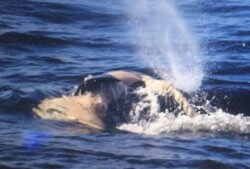
Photo of Tahlequah from the Center for Whale Research.
“The spray of water and exhalation is coming from the top of J-35’s head, and the white tube-like structure draped over the foreground side of her head is the baby’s intestine. The white blob seen underwater is what remains of the skin and blubber surrounding the baby’s head.”
August 9: 6 pm PT – This is the plan for what happens if/when we encounter Scarlet:
- Collect breath sample (via long pole)
- Collect fecal sample (scooped from the water)
- Other sampling of mucus and/or skin if practical (via long pole)
- Simultaneously complete visual veterinary health assessment
- Provide antibiotic treatment through pole system or dart
After these steps are complete, the teams will consider using live fish to provide medical treatment. Since nothing like this has been attempted before, they would first conduct a trial release of live fish to see if Scarlet will take the fish. The team would release fish from a vessel through a chute about 50 to 100 yards in front of her. And if she takes it, the team will discuss delivering oral medications inserted into the live fish based on the outcomes of the veterinary assessment
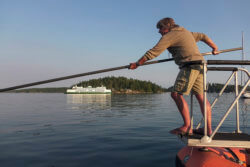
Jeff Foster of the Whale Sanctuary Project checks the pole that will be used to collect breath samples during the planned health assessment of J50. (Photo: John Gussman/NOAA Fisheries)
August 9: 12 pm PT –The team is on the water now, ready to respond as soon as the pod is within range, and conditions allow them to assess Scarlet’s health and also to monitor the condition of Tahlequah.
Note: NOAA emphasizes that the mission of the team is not to start an ongoing feeding program for Scarlet (which could habituate her to being fed from boats). If a decision is made to feed her, the purpose would be to introduce medicine to treat an infection, rather than to provide nutrition.
August 8: A Canadian team from the Department of Fisheries and Oceans (DFO) spotted J pod in U.S. waters off the Olympic Peninsula northwest of Neah Bay. Scarlet was with her mother, J16, known as Slick. Teams are preparing to approach Scarlet tomorrow in order to collect breath and fecal samples so they can assess her health. They may also attempt to give her some medication, if there is opportunity.
August 8: After not seeing Tahlequah for a week, teams spotted her today. She is still carrying her dead infant daughter – a heartbreaking sight.
August 7: Scarlet was spotted by Dept. of Fisheries and Oceans Canada with her pod off Port Renfew, near the west entrance to the Strait of Juan de Fuca. Throughout the day, as some teams searched for J50, other partners in the effort continued making important preparations to be ready for an opportunity to assess J50’s health.
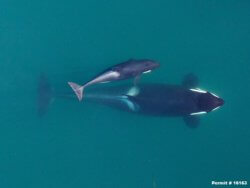
Aerial photo of J16 with her calf, Scarlet, in 2015, when Scarlet was less than a year old. Photo by John Durban (NOAA Fisheries), Holly Fearnbach (SR3) and Lance Barrett-Lennard (Vancouver Aquarium), taken by an unmanned hexacopter during research authorized under NMFS permit #16163.
August 6: Responders continued searching for J pod today without success. The whales have not been seen since Saturday night, when spotted in open waters on the west side of Vancouver Island. Veterinarians are on standby to conduct a health assessment of Scarlet.
August 4: Scarlet was seen with the J pod around the west side of Vancouver Island, beyond the reach of most response vessels. We are awaiting an opportunity to complete a veterinary medical assessment.
August 3: Analysis of a small sample of Scarlet’s breath did not definitively indicate an infection or illness, although it does not rule one out either.
August 2: Experts agreed to focus efforts over the next few days on obtaining better photographs of Scarlet and conducting a veterinary health assessment to inform options for a decision on whether and how they might be able to respond.
Title photo is of Scarlet/J-50 with her sister Echo/J-42, by Katy Foster/WSP/for NOAA.
17 Comments
Thank you from all the way over in Prague, to all those looking out for Scarlet’s welfare…professionals, volunteers, locals in the area. Lets hope she makes it…her story has worked its way deep into my heart and makes me realise how much the PNW is forever a part of who I am. …Swim Scarlet Swim.
Thank all of your dedication.
Thank you all, I’m relieved & will wait good news.
Thank you so much for the updates. I’m so worried about sweet Scarlett.
Thank all of you, I am with you all.
Thank all of you for your love and dedication! I however feel that the problem started with the dams– What and when are they going to do something. There was a meeting, a bunch of us signed petitions and even called and wrote letters to this Governor. What more can we do? I do not feel that we should be sitting back doing nothing about this! This is OUR Oceans and OUR Marine Life. OUR Voices should mean something!!!
This is such an exciting moment in caring for them in the wild. It is deplorable that all this is a result of lack of food. But, at least we are learning more from tests and for sure delivery methods to treat them. All of You are doing a fantastic job and it is wonderful that the world is viewing & taking notice. Now to get those dam dams breached!
Could Scarlet have swallowed plastic? Can this be the cause of her losing weight? Plastic in the ocean has become a huge problem lately. She might have eaten it by mistake in that case.
I have read that marine animals who get plastic in their stomach have a harder time getting the nutrients from other prey they hunt and that the plastic slowly makes them ill.
It’s a possibility, both as you describe it and also in that she could have a blockage. These are among many possibilities that have been discussed when Scarlet is being observed from the boats … and also, incidentally, from the air since the team is using a drone to see what can’t easily be observed from the boats.
Thank you doing “action”, leaving politics out of it and for caring about our Orcas….it means the world to us. They are the indicators of the health of our world.
I left a donation but it has not been taken out of my account how long does it take
Thank you very much for the donation. Please email us at info@whalesanctuary.org so we can check on it for you.
Thank you for all your dedication and efforts ,
thank you SO much for your efforts and good luck!
Thank-you for all your dedication and efforts! My prayers go with you!
that is the saddest thing I’ve heard in so long re:Tahlequah. was the baby just underweight or I wonder why she didnt survive?
Heartbreaking, for HER and for us for having one less whale for us to watch and appreciate.
Successful Day! Thank God for all of your efforts. Praying for them. xoxo